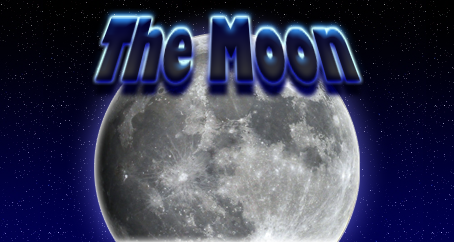Fourteen Facts about the Moon
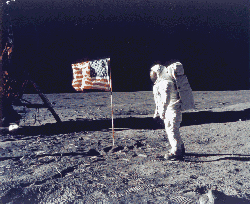
Fact One
Other than Earth, the Moon is the only surface in the Solar System to have been stepped on by human beings.
IMAGE TO THE LEFT: Buzz Aldrin standing near the American flag during Apollo 11
Fact Two
Footprints on the Moon will remain there for millions of years.
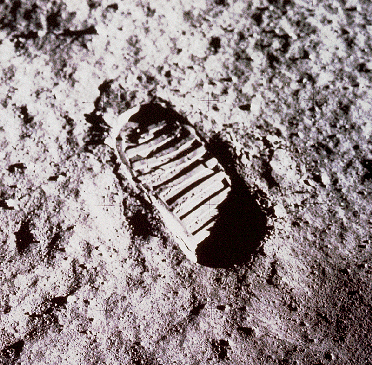
Fact Three
The Moon has no atmosphere. It is through atmosphere that light is dispersed (spread) and sound waves travel (light waves and sound waves bounce off tiny particles in an atmosphere). This means that no sound can be heard on the Moon. The sky is always black because light cannot be spread, unlike on Earth where light spreads to give the sky a blue colour and on Mars where it spreads through its thin atmosphere to give the sky a pinkish/reddish colour.
Fact Four
The Moon had a volcanic history. A picture taken in 1994 by the Clementine mission shows a volcano on the Moon's South Pole from millions of years ago. This is fairly recently in the Moon's history (most of the surface features of the Moon are billions of years old), which explains why there are few impact craters nearby.
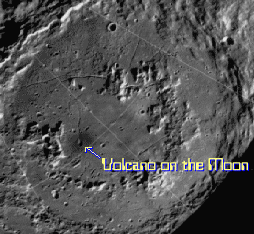
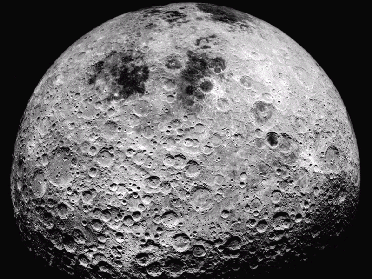
Fact Five
We only ever see one side of the Moon. This is because when it formed and its inner liquids went solid, most were pulled towards Earth, making it slightly egg-shaped, heavier on one side (the side that we can see) and therefore not able to spin freely. Instead, it spins with the Earth. As the opposite side of the Moon is never seen from Earth, it is often referred to as the "Dark Side of the Moon." This is despite the fact that it actually receives just as much light from the Sun as the visible side.
Fact Six
The first time people on Earth ever saw the "Dark Side of the Moon" was on 7th October 1959 when the Soviet (Russian) spacecraft, Luna 3, sent back the first pictures. This revealed that the far side of the Moon is much more cratered than the side facing Earth. The cratered far side of the Moon can be seen in the picture above.
Fact Seven
Only 12 people have stepped on the surface of the Moon, spread over six missions between 1969 and 1972. All of these landings have been American. Those astronauts are Neil Armstrong, Edwin "Buzz" Aldrin, Pete Conrad, Alan Bean, Alan Shepard, Edgar Mitchell, David Scott, James Irwin, John Young, Charles Duke Jr., Eugene Cernan and Harrison Schmitt.
Fact Eight
In 1610, the Italian astronomer, Galilei Galileo noticed that the Moon had craters caused by meteorite impacts. This disgraced people at the time who believed the Moon to be a perfect sphere created by the gods.
Fact Nine
The first manned moon landing was on 20th July 1969 (Apollo 11 launched on 16th July 1969). The last manned moon landing was three years later on 11th December 1972 (Apollo 17 launched on 7th December 1972).
Fact Ten
The Moon is the fifth biggest moon in the Solar System. The moons larger than it are Ganymede and Callisto of Jupiter, Titan of Saturn and Io of Jupiter. The Moon is also larger than the dwarf planets Pluto and Eris. It is the 14th largest known object in the Solar System (click here for a list of the Solar System objects by size)
Fact Eleven
Despite the manned lunar missions being named after Apollo, in classical mythology, Apollo is actually the god of the Sun.
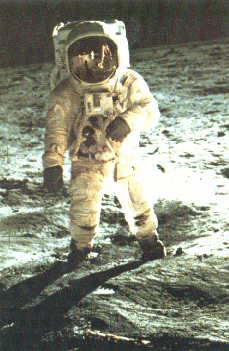
Fact Twelve
The famous picture to the left is quite often mistakenly believed to be a picture of Neil Armstrong on the surface of the Moon. It is in fact a picture of Buzz Aldrin on the Moon during the Apollo 11 mission. However, Neil Armstrong can be seen in the reflection of Buzz Aldrin's visor.
Fact Thirteen
Buzz Aldrin's mother's maiden name is Moon!
Fact Fourteen
Selenophobia is the name given for the persistent and irrational fear of the Moon. Sufferers of this phobia have panic attacks, with symptoms including sweating, trembling and feeling faint, whenever seeing or thinking about the Moon. The attacks are often stronger when the Moon is bright or full.

View facts about other destinations

Moon Statistics Table
| Name | The Moon / Luna |
| Meaning of Name | Luna is the Roman goddess of the Moon |
| Name in Foreign Languages | Lune (French), Luna (Spanish, Italian, Latin), Mond (German), Lua (Portuguese), Selene (Greek) |
| Average Distance from Earth |
384,400 km / 238,855 miles / 0.0025 A.U. Comparison with Earth's distance from the Sun: 149,597,890 km / 92,955,820 miles / 1.000 A.U. |
| Closest Distance to Earth (Perihelion) | 363,300 km / 225,700 miles / 0.0024 A.U. Comparison with Earth's distance from the Sun: 147,100,000 km / 91,400,000 miles / 0.983 A.U. |
| Farthest Distance from the Sun (Aphelion) |
405,500 km / 252,000 miles / 0.0027 A.U. Comparison with Earth's distance from the Sun: 152,100,000 km / 94,500,000 miles / 1.017 A.U. |
| Diameter across equator | 3,476 km / 2,159 miles Comparison with Earth: 12,756 km / 7,926 miles |
| Diagram showing planet's size compared to the size of Earth |
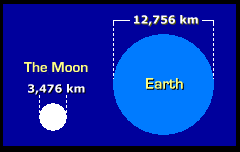 |
| Circumference around equator |
10,916 km / 6,783 miles Comparison with Earth: 40,074 km / 24,901 miles |
| Mass | 73,483,000,000,000,000,000,000 kg Comparison with Earth: 5,973,700,000,000,000,000,000,000 kg |
| Time to spin on Axis | 27 days, 8 hours (note that there is a new moon every 29.5 days) Comparison with Earth: 23 hours, 56 minutes |
| Time to orbit Earth | 27 days, 8 hours Comparison with Earth's orbit of the Sun: 365 days, 6 hours |
| Distance planet travels to complete one orbit | 2,290,000 km / 1,423,000 miles Comparison with Earth's orbit of the Sun: 924,375,700 km / 574,380,400 miles |
| Gravity (Earth = 1) | 0.166 |
| Escape Velocity | 8,568 km/h / 5,324 mph Comparison with Earth: 40,248 km/h / 25,009 mph |
| Minimum Surface Temperature | -233 °c / -387 °F / 40 K Comparison with Earth: -88 °c / -126 °F / 185 K |
| Maximum Surface Temperature | 123 °c / 253 °F / 396 K Comparison with Earth: 58 °c / 136 ° F / 331 K |
| Weather Conditions | The lack of atmosphere on the Moon means there is no "weather", although temperature ranges are extreme depending on whether it is Lunar day or night both of which last for 14 days. |
| Contents of Atmosphere | None |
| Past Missions (including nationality and year of launch - failed missions in red) | Pioneer 0/Thor-Able 1 (USA, 1958), Luna 1958A (USSR, 1958), Pioneer 1 (USA, 1958), Luna 1958B (USSR, 1958), Pioneer 2 (USA, 1958), Luna 1958C (USSR, 1958), Pioneer 3 (USA, 1958), Luna 1 (USSR, 1959), Pioneer 4 (USA, 1959), Luna 2 (USSR, 1959), Luna 3 (USSR, 1959), Pioneer P-3 (USA, 1959), Ranger 3 (USA, 1962), Ranger 4 (USA, 1962), Ranger 5 (USA, 1962), Luna 4 (USSR, 1963), Ranger 6 (USA, 1964), Ranger 7 (USA, 1964), Ranger 8 (USA, 1965), Ranger 9 (USA, 1965), Luna 5 (USSR, 1965), Luna 6 (USSR, 1965), Zond 3 (USSR, 1965), Luna 7 (USSR, 1965), Luna 8 (USSR, 1965), Luna 9 (USSR, 1966), Luna 10 (USSR, 1966), Surveyor 1 (USA, 1966), Lunar Orbiter 1 (USA, 1966), Luna 11 (USSR, 1966), Surveyor 2 (USA, 1966), Luna 12 (USSR, 1966), Lunar Orbiter 2 (USA, 1966), Luna 13 (USSR, 1966), Lunar Orbiter 3 (USA, 1967), Surveyor 3 (USA, 1967), Lunar Orbiter 4 (USA, 1967), Surveyor 4 (USA, 1967), Explorer 35 (USA, 1967), Lunar Orbiter 5 (USA, 1967), Surveyor 5 (USA, 1967), Surveyor 6 (USA, 1967), Surveyor 7 (USA, 1968), Luna 14 (USSR, 1968), Zond 5 (USSR, 1968), Zond 6 (USSR, 1968), Apollo 8 (USA, 1968), Apollo 10 (USA, 1969), Luna 15 (USSR, 1969), Apollo 11 (USA, 1969), Zond 7 (USSR, 1969), Apollo 12 (USA, 1969), Apollo 13 (USA, 1970), Luna 16 (USSR, 1970), Zond 8 (USSR, 1970), Luna 17 (USSR, 1970), Apollo 14 (USA, 1971), Apollo 15 (USA 1971), Luna 18 (USSR, 1971), Luna 19 (USSR, 1971), Luna 20 (USSR, 1972), Apollo 16 (USA, 1972), Apollo 17 (USA, 1972), Luna 21 (USSR, 1973), Luna 22 (USSR, 1974), Luna 23 (USSR, 1974), Luna 24 (USSR, 1976), Hiten/Muses-A (Japan, 1990), Clementine (USA, 1994), Lunar Prospector (USA, 1998), SMART 1 (Europe, 2003), Chang'e 1 (China, 2007) |
| Present Missions | SELENE (Japan, 2007), Chandrayaan-1 (India, 2008) |
| Planned Missions | Lunar Reconnassance Orbiter (USA, 2009), Moonlight (UK, 2010), Chandrayaan-II (India, 2010/2011), Luna-Glob (Russia, 2012), SELENE 2 (Japan, 2012), Project Constellation (USA, 2008-2020), Aurora Programme (Europe, 2024), Chang'e (China, 2024) |
